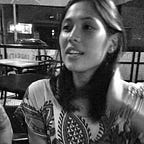3 Watch-Outs when Conducting Fieldwork: A Straight-talking Guide to Design Research
The first bit of my no-sugarcoating guide on lessons from…the field.
I recently did a design research (user research) project, and I invited people, who are interested in learning the process, to observe how it’s done.
That gives me the benefit of having extra eyes and ears to challenge my observations, and it also helps me build others’ competence or skills in a field that still isn’t widely known here. ☺
To continue sharing what I love doing in a useful way, these are three points to remember, when going on field:
1. Go out in groups
(Or, if that’s too hard — pairs.)
It’s challenging to conduct qualitative and user research alone.
Challenging — because you’d have to be a kick-ass analyst to be sure of your qualitative insight, if you analyzed it purely by yourself.
Unlike quantitative research (whose strength is producing data that you can apply to a total sample of people), the harsh reality is that qualitative research is subjective — because you do it with a “non-readable” base (Meaning the number of people you interview is too low to be considered statistically significant).
Qualitative research is about understanding needs and culture — the perceptions of which are affected by personal biases. (One of my bosses even made us go through self-awareness workshops once a year. To make sure we faced even the parts of our personality we didn’t want to talk about.)
You need other people when doing qualitative research. Because, just like in product design, you need someone who will look at the same idea and challenge you about your perception, in case you’re really just being biased by your own background — which is inevitable.
So, in my experience, the best qualitative projects I’ve worked on have one or both elements:
1) Quantitative data to validate qualitative in-depth findings.
2) Teammates who represent different backgrounds and personalities. And are open to assessing their biases.
2. Shut up.
Don’t “teach” users.
Especially for user research — where you’re trying to understand how a person interacts with a multi-feature product, the point is to let them do what they would most naturally do (given the artificial setting).
So don’t teach them how to do it.
3. Research is work.
It isn’t glamorous. It’s cool, yeah. But it isn’t a glitzy job.
There is no point in sugarcoating the effort of doing research.
It’s probably why A Book Apart entitled their research book: “Just Enough Research”. Because they know that you’re probably only going to do enough.
The trick is, I think, you have to understand why you’re doing it. Especially when you’re on your 8th interview and you’re listening to someone’s daily routine all over again.
You have to be prepared for this kind of repetitiveness, because you can’t be an expert on your users if you’ve only interviewed one person. Research is about patterns. Differentiation. Multiple voices.
So, imagine going up to people, orienting them about the study, observing them and listening to them for a minimum of 30 minutes. Multiplied by the number of people you want to talk to.
That is what research fieldwork is like.
And you need to go through it if you want to improve how your services are designed.
*An added footnote, especially for design research about digital products: In case you forget (like I did), make sure all of your recording equipment and devices are fully charged ☺
And that you have enough memory, a tripod and a mobile Internet device. Just some practical advice.
Thank you to Ash del Rio, Jigo Reloj and Ghesty Francisco for sharing what you learned and walking with me to different houses on the hottest days of the year.
Follow me here on Medium, or on Twitter, for more straight-talking, practical stories about how to plan, execute and analyze design research. Message me if ever you want to work together.
